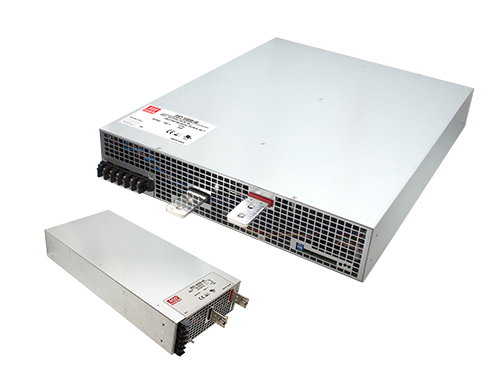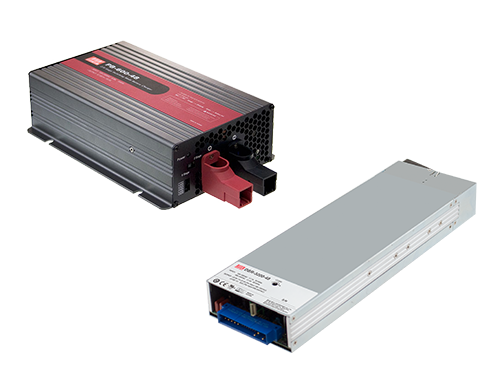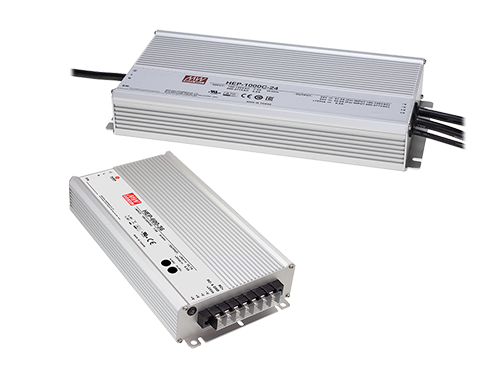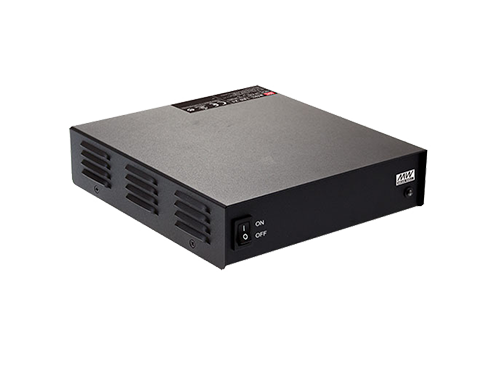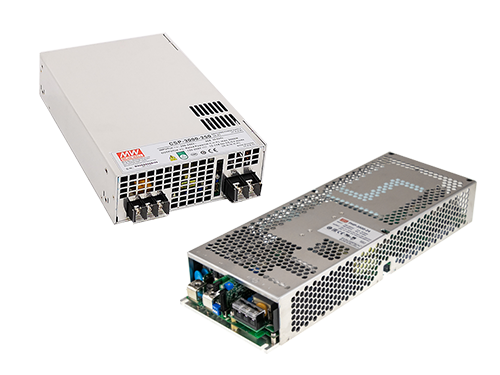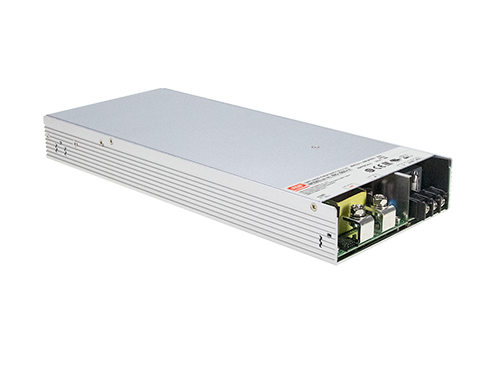BATTERY: INDUSTRIAL CHARGER & PROGRAMMABLE POWER SOURCE
With the democratization of mobile devices, the drop of manufacturing cost of batteries, as well as the growing awareness on environmental topics issues, the technology of batteries and chargers has witnessed a tremendous breakthrough in the past few decades; numerous of new batteries have seen the light of day, and innovative charger applications are born as accompaniment.
From Electric Vehicle Charging (EV Charging) infrastructure to Energy Storage System (ESS), the modern chargers are utilized in numerous different sectors nowadays and are pushing the society further towards the more sustainable and renewable energy options.
MEAN WELL INDUSTRIAL CHARGERS
MEAN WELL is the global leading manufacturer of standard Power Supplies in the market. With over 40 years of experience in the development and production of Power Supplies, MEAN WELL offers a complete range of charging solutions to diverse fields, including the household, commercial and public sectors.
HOW CHARGER IS DIFFERENT FROM REGULAR POWER SOURCE
While common Power Supplies are designed to provide a fixed and constant DC voltage, chargers require a more complex design with different charging phases to assure the longevity of batteries and safety during operation.
To meet the specific charging needs of different types of batteries, industrial chargers are generally designed with several charging phases, including principally a boost voltage-constant current phase, a constant voltage phase, and a float voltage phase.
More advanced industrial chargers use a microcontroller (MCU) design, which detects the charging status of the connected batteries and allows further adjustment between different charging phases.
Nevertheless, it does not mean that chargers are the only option for charging applications nowadays. Advanced technology in power supplies has made it possible to adapt a programmable power supply, with adjustable voltage and current, to the specific charging demands in the field too.
HOW TO CHOOSE YOUR CHARGER
Choosing the adequate DC power source for the battery is critical if one wishes to maintain the battery’s performance. In the following paragraphs, we will be listing down a few criteria which are considered essential when it comes to the selection of proper chargers for the system.
A. Battery Charging Profile
Each battery type has its own specific charging needs and requirements. These requirements are normally defined by the battery manufacturer and listed in their specification. Hence it is important to start by identifying the battery charging profile before further diving into choosing the suitable charger. For the 2 most popular battery types used, we listed 2 example charging curves below:
- Lead-Acid Battery requires chargers with minimum 3 charging stages.

Image 1: Three Stages for Lead-Acid Battery
- Lithium-based Battery requires generally chargers with 2 charging stages: first with constant current, followed by constant voltage.
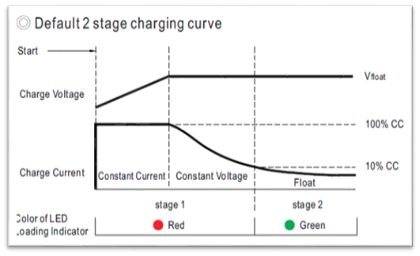
Image 2: Two stages for Lithium-based battery (LiFeP04, LiCoO2)
For more information read our “Lead-acid and lithium battery charging” article.
For more information about selecting the right charger for your battery please refer to our “Selecting a charger from your battery” article.
Tip: MEAN WELL offers a Smart Battery Charging Programmer (SBP-001) which allows users to configure via a user-friendly interface, the charging curve of selected MEAN WELL chargers and power supplies (e.g. Intelligent RCB-1600 charger, HEP-1000 for Harsh environment, ENC…etc.). With SBP-001 programmer, the user can set the output current and voltage to further simulate the charging curve for different batteries.
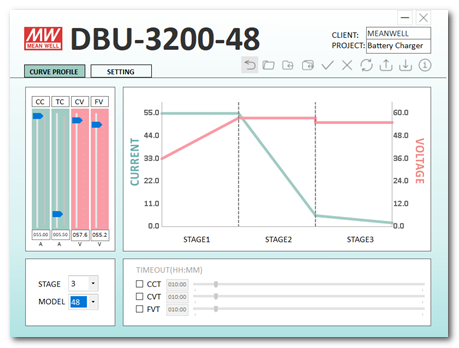
Image 3: Intelligent Charger DBU-3200, configurated via SBP-001 and its user-friendly interface (Click to download)
B. Regulations
According to International Electrotechnical Commission (IEC), numerous regulation standards exist for the purpose of ensuring safety, efficiency, reliability, and interoperability of electrical, electronic, and information technologies; depending on the application of the end device, the mandatory regulations can differ from one to another.
For instance, IEC/EN 60335-1 is the basic requirement for Household appliances’ design, aiming to prevent foreseeable hazards ones could encounter when using the end device. Furthermore, IEC/EN 60335-2-29 defines the requirements in detail for battery chargers intended for household battery charging.
Specific charger applications such as AC EV Charger might require an additional power source to power the auxiliary and communication modules inside the such charger. For these kinds of applications, one has to evaluate on the system level if power supplies with more strict requirements are needed, such as the IEC/EN 61558-1 certification and compliance with OVC III (Overvoltage category III) protection level. Power Supplies with OVC III compliance can be integrated without adding an extra isolation transformer on the input side and gives your products the best out in terms of flexibility and costs in a minimized space. In addition, using such power supplies in AC Charters gives greater flexibility in terms of installation as these would allow the charger to be permanently connected to a distribution panel.
As for chargers intending to power up UPS systems and battery test systems, IEC/EN 62368-1 and IEC/EN 62477 are generally the safety regulations to comply with.
In addition, the standards related to electromagnetic compatibility (EMC) emission and immunity are equally important to take into consideration. In case the charging system is certified according to the IEC/EN 62368-1; the EN 55032 and CISPR 32 standards must be confirmed; in case the system needs to be certified for the IEC/EN 60335-1, the emissions and immunity according to the EN 55014 have to be met. Other major EMC regulations which must be complied with are the IEC/EN 61000-3 and IEC/EN 61000-4.
Therefore, clarifying the specific requirements for safety and EMC regulation standards will greatly facilitate the selection of the battery charger process.
| Safety Regulation No. | MEAN WELL Series |
| EN62368-1 | HDR-15/30/60/100/150 ENC-120/180/240/360 NPB-120/240/360/450/750/1200/1700 RPB-1600 / RCB-1600 / DBR-3200/ DBU-3200 HEP-600C CSP-3000 PHP-3500 RST-10000/ 5000 BIC-2200 TDR-240/480/960 WDR-60/120/240/480 Adapter Charger: GC30/120/160/220/330 |
| OVC III (based on EN61558) | HDR-15/30/60/100/150 *PHP-3500 |
| OVC III (based on EN62368) | IRM-30/45/60/90 |
| EN60335-2-29 / EN60335-1 | NPB-120/240/360/450/750/1200/1700 |
| EN60335-1 | IRM-60/*90 *PHP-3500 |
*=Regulation Designed Ready, NRE needed by users request
C. Installation
The working environment and condition are essential to the reliability and lifetime of both battery and charger; engineers must take into consideration the eventual working and storage condition of the battery charger to further choose an adequate model for the design.
For instance, chargers designed as 5G vibration-proof are more suitable for installation located in a mobile device. E.g., wheelchair, E-bike, mobile working station, camper van…etc. Whereas waterproof and dust-resistant IP67 chargers and power supplies are generally recommended for application under humid and dusty environment, both indoor and outdoor.
On the other hand, it is not to forget that the working temperature is equally important to the longevity of battery charger and battery as the other working conditions mentioned earlier. Therefore, one should think about selecting a power source with adequate thermal dissipation design (e.g., convention cooling, forced air flow, conducted colling, water cooling…etc..) for the system too.
Last but not least, the selection of battery charger is sometime limited by the available space or specific installation method too; a 19-inch rack cabinet will probably need an 1U Battery Charger (e.g., 1U-tall RCB-1600) to save space and a DIN Rail cabinet will most likely adapt a DIN RAIL power source (e.g., HDR series with OVC III protection)…etc.
Future postings and articles:
In the upcoming future, MEAN WELL will also share its knowledge regarding the booming Energy Storage System (ESS) field. For instance, how to use MEAN WELL Chargers (programmable 67~400VDC) in a High Voltage Direct Current (HVDC) application, as well as the know-how on digital communication protocols (e.g., PMbus and CANbus), which can further perform voltage and current control for the Energy sector.
LEARN MORE ABOUT CHARGING POWER SUPPLIES
Explore our blog for insightful technical notes about Charging Applications.
Got questions?
Look at the section below to find the most frequently asked questions (with answers)
we received in Charging Applications.
The GTIN number can be found directly on the www.meanwell.com:

Yes, MEAN WELL products are registered in SCIP. To get such information for specific power supply, please follow the steps below:
- Go to https://echa.europa.eu/en/scip-database
- Under SEARCH option, choose „Article Identity” and write down model name e.g. RSP-1600.
- As “Identifier type (optional)”, please chose “Other”
- Click “Search” button

All the latest KNX firmware updates can be found on ETS Online Catalogue or MEAN WELL website dedicated to KNX products.
a. Got to KNX Building Automation Solution-MEAN WELL -> Downloads -> ETS Application Database

b. Click on Download button to see PDF file with all the hyperlink for specific products.

Find the latest news in the MEAN WELL APP


You can follow us on LinkedIn:

Go to:
https://www.linkedin.com/company/meanwell-europe-b-v-/
1. Click follow
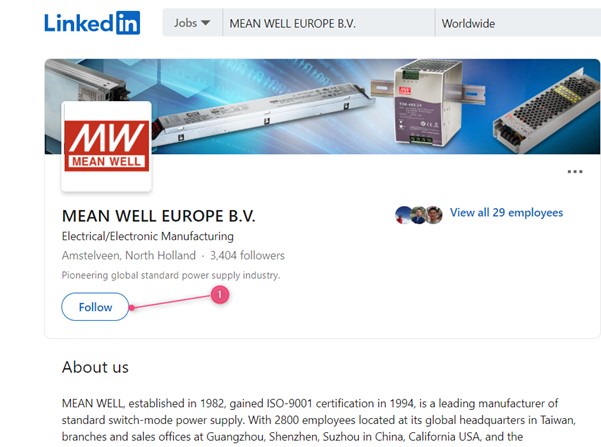
And you could install our APP see our FAQ “How to subscribe to MEAN WELL’s newsletter?”
MEAN WELL’s distributor information can be found on Distributor Network-MEAN WELL Switching Power Supply Manufacturer
- Click on the region that you are located
- Select the country you are in
- Click on the search button
- Scroll down to see our local distribution channels
- Look for the distributor with a tick for the product group that you are looking for

MEAN WELL has the largest distribution network for serving your small and medium demand Power Supplies. You can find all MEAN WELL’s distribution channels on Distributor Network-MEAN WELL Switching Power Supply Manufacturer.
OEM’s which have no sales channel for MEAN WELL products yet can contact us via the “Contact Us” form on this website.
MEAN WELL’s discontinued product schedule and End of Life products are normally updated 2 times per year, in January and in July and are published on www.meanwell.com. See FAQ “Where can I find MEAN WELL’s discontinued product schedule and End of Life information? “
The normal procedure for E.O.L. is:
- The product or series is announced in the Discontinued product list in January or July and announced as NRND (Not Recommend for New Design)
- 6 months later the lead time of the product or series will increase +30 days, the price will increase as well.
- Another 6 months later, the lead time will increase another +30 days (so + 60day compared to the original lead time), the price will increase again.
- Another 6 months later, the lead time will increase another +30day (so +90 days compared to the original lead time) and the price will increase again and additionally there will be a MOQ of 200pcs (and steps of 100 for higher quantities)
- After another 6 months the last buy is announced on the website. This will be the last opportunity to place an order for this product or series.
In total MEAN WELL’s End of Life, procedure will take 2 years. However, there are situations for instance that certification is expired, or some components can no longer be obtained by the market which will force to accelerate the EOL schedule. Therefore, it is always highly recommended from the moment that a product is on the discontinued list to design in one of our new generation products. If need any advice to this, please use the “Contact Us” function on this website.
MEAN WELL’s discontinued product schedule and End of Life products are normally updated 2 times per year, in January and in July. To see the full list, go to www.meanwell.com
1. Click on products
2. Click on Discontinued products for the schedule for the EOL schedule
Click on EOL for the MEAN WELL products which are End Of Life

You can use the “Contact Us” function on this website
MEAN WELL’s website provides you all the basic information about our Power Supplies. This includes company news, product announcements, ISO certificates, Specifications, test report, Certificates, ROHS declarations, Reach declarations and many more.
MEAN WELL’s products can be found on www.meanwell.com
1. Click on products and select the product category

Or in case you already have a part number, you can use the search function on the website:
2. Use the search function on the website to find the right product
3. Fill in the series number in the search field (do not include the last extensions such as -12 in XLG-150-12)
4. Click the search button

5. Click on the PDF icon to open the specification

MEAN WELL has incorporated dust proofing and waterproofing into the majority of its LED power supply design. Mainly based on the international standard IEC60529, detailed descriptions can be found in the following table:
(Note: PSUs with IP64 rating or above are suitable for indoor or outdoor applications in sheltered locations)
IP xy protection level
| Degree of protection, foreign bodies (x) | Degree of protection, moisture(y) |
| 0. Not protected 1. Solid foreign object (>50mm) 2. Solid foreign object (>12mm) 3. Solid foreign object (>2.5mm) 4. Solid foreign objects of 1,0mm diameter and greater 5. Amount of dust that would interfere with normal operation Dust tight | 0. Not protected 1. Vertically falling water drop 2. Vertically falling water drop when enclosure is tilted up to 15 degrees 3. Water sprayed at an angle up to 60o on either side of the vertical 4. Water splashed against the component from any direction 5. Water projected in jets from any direction (12.5 liter/minute) 6. Water projected in powerfil jets from any direction (100 liter/minute) 7. Temporary immersion in water ( 1 meeter from the surface of the water for 30 minutes) 8. Continuous immersion in water, or as specified by the user / manufacture |
*IP64-IP66 level products are suitable for damp indoor or sheltered outdoor environment. For actual installation limitations, please refer to the corresponding IP level tests.
*All products cannot be continuously submerged in water.
*The definition of IP68 by MEAN WELL: Immerse a unit under test in 1 meter below the surface of the water, tested with a dynamic condition where 12-hour AC on; 12-hour AC off.
Test duration: 1 month.
LED Drivers are recommended operate at full load as long as it observes the working temperature specified in the datasheet, which means Tc measurement results should be equal to or less than the stated Tc in the datasheet. 5 years warranty complies as long as drivers operate within working Temperature and Tc. Limit as well.
No, they are different. SELV means the LED driver will use a safety isolating transformer with double or reinforced insulation and the output voltage shall not exceed 120Vdc.
This is good for the end product safety certified if the LED driver with SELV output.
The definition of SELV was defined in the IEC 60950 standard but it is not defined in the IEC 62368 standard. This has been replaced with the ES1 Energy sources definition.
The definition of SELV is still applicable to the 61347-2-13 standard. In this standard it is that a LED driver will use a safety isolating transformer with double or reinforced insulation and the output voltage shall not exceed 120Vdc.
In the specification MEAN WELL’s 61347-2-13 certified LED drivers are marked with the SELV symbol in the case that the SELV requirements are fulfilled:
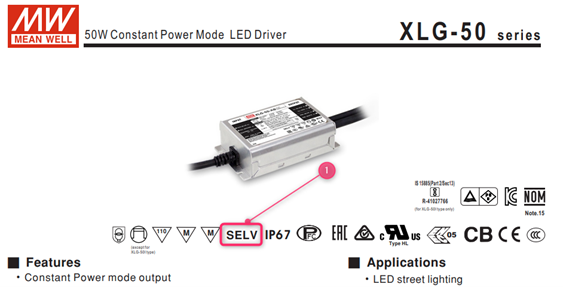
MEAN WELL’s safety reports, IEC reports and CB reports are not available online. In case you need these reports to validate your design with your certifying body, please contact your local MEAN WELL sales channel for support. If you are unable to get the support, please contact us via this website.
MEAN WELL’s User Manual can be found on www.meanwell.com
1. Go to products
2. Click on Installation Manual

3. Scroll down to find the user manuals for the different product families.

MEAN WELL’s Safety certifications can be found on www.meanwell.com
- Use the search function on the website
- Fill in the series number in the search field (do not include the last extentions suchs as -12 in XLG-150-12
- Click the search button

4. Click on the PDF Link

5. Click on the top on the certificate
6. All available certificates are shown and will show up once clicked upon

MEAN WELL’s CE declarations can be found on www.meanwell.com
- Use the search function on the website
- Fill in the series number in the search field ( do not include the last extentions suchs as -12
- Click the search button

4. Click on the PDF Link

5. Click on the top on certificate
6. Click on CE declaration

Select (1) Products followed by (2) downloads
MEAN WELL’s EMI test guide can be found on www.meanwell.com
Select (1) Products followed by (2) Downloads

After this scroll down to find the EMI testing of Power guide

Or you can use this link to directly download the EMI testing guide:
EMI_statement_en.pdf
MEAN WELL’s RoHS and Reach statements can be found on www.meanwell.com
Select (1) Products followed by (2) Downloads:

After this scroll down to find the RoHS declaration and Declaration of SVHC/ REACH conformity:

Or you can use the below links to download the declarations:
MEAN WELL’s Declaration of Conflict Free Minerals can be found on www.meanwell.com
Select (1) Products followed by (2) Downloads

After this scroll down to find the Declaration of Minerals Conflict Free

Or you can use this Link to directly download the EMI testing guide:
